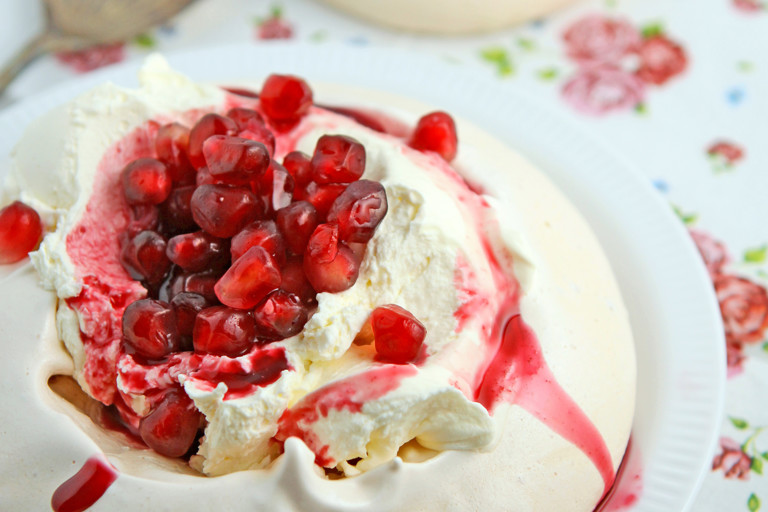Pomegranate Pavlova
Ah, who doesn’t love a good, juicy argument? I’m sure it is imprinted on our genes to be attracted to disputes and disagreements: we all have an opinion, we all love to share ours, and we all like to defend it to the death. So there can be few things more riveting for a foodie than a juicy argument over the origins of a particular recipe.
Take the pasta dish of bucatini all’amatriciana. It’s an Italian classic, but there seems to be no agreement on its origins. Residents of the central Italian town of Amatrice say they’re the ones who created it and point at the name as proof. But Roman chefs are equally convinced that their forebears in Rome invented it and merely nodded to the town of Amatrice in the name. The Caesar salad, so ubiquitous on menus around the world is also in dispute. The story usually goes that Cesare Cardini Caesar, who was born near Lago Maggiore in Italy but emigrated to San Diego, invented it on a busy weekend at his Tijuana restaurant when he ran short of supplies. Not wanting to disappoint the customers, he concocted this salad with what he had on hand and prepared it at the table to add flair to a somewhat makeshift dish.
It caught on and the rest is history. But Paul Maggiora, a partner of the Cardini's, claimed that he created the first Caesar salad in 1927 for American airmen from San Diego and called it "Aviator's Salad”; Caesar's brother Alex also claimed to have developed the salad; and a chap called Livio Santini claimed he made the salad from a recipe of his mother, in the kitchen of Caesar's restaurant when he was 18 years old, in 1925, and that Caesar took the recipe from him.
Even more bizarrely, there are some who claim that the Italians did not invent the recipe for lasagne but that the British did. Evidently in the first published cook book in Britain, published during the reign of Richard II in the 14th Century, there is a dish called loseyns (pronounced “lasan”) consisting of layers of cheese, meat and pasta. It could be that the Romans brought the recipe during their conquests, or it could be that 14th century England was a more adventurous place that we thought!
But the most hotly contested recipe of all time, still being debated nearly 100 years after its invention, is surely the Pavlova. Undisputed is the fact that it is named after Russian ballerina Anna Pavlova when she toured the antipodes in 1926 and 1929, and consists of a meringue base topped with whipped cream and fresh fruit. However, that’s where the agreement ends. In the Australian version, Chef Bert Sachse at the Esplanade Hotel in Perth, Australia was asked to create a new dessert for afternoon tea. His meringue had a crisp exterior and a light, fluffy interior, and the hotel owners pronounced the dessert “as light as Pavlova herself”. Thus the Pavlova was born. But there is also an entry in the 1926 cookbook Home Cookery for New Zealand described as "Meringue with Fruit Filling" (the name ‘Pavlova’ is not used but the recipe is similar). A year later, another New Zealand cookbook included a recipe called “Pavlova” but it was a gelatine based dish. And in 1929, a magazine published a recipe for the meringue and fruit confection that we know today. And so the delicious dispute rumbles on.
I don’t really mind where the recipe came from – I just know it is one of the easiest and most versatile desserts I know. I have made it with a variety of fruit, but for this time of year, pomegranates are my favourite – particularly as they are associated with romance and Valentine’s day. I made my own pomegranate syrup but if you are pushed for time you could buy ready made pomegranate molasses. Do make your own meringues though – they are always worth the extra effort!
Ingredients
Metric
Imperial
- 2 large egg whites
- 112g of caster sugar
- 1/2 tsp cornflour, or cornstarch
- 1/2 tsp white wine vinegar
- 1 pinch of cream of tartar
- 175ml of double cream
- 2 pomegranates, large
- 50g of granulated sugar
Method
Get in touch
Please sign in or register to send a comment to Great British Chefs.


